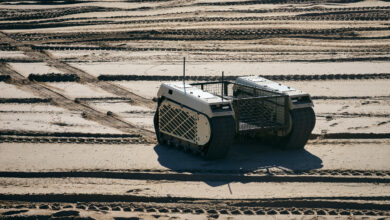Turkish Robot Vehicle Test-Fires Kamikaze Drones
A Turkish unmanned ground vehicle (UGV) recently test-fired loitering munitions, a first in its class.
Havelsan’s Barkan 2 UGV demonstrated launching reconnaissance, surveillance, and kamikaze munitions on October 12, the Turkish defense firm stated.
The munitions were fired up to 15 kilometers (9.3 miles), at an altitude of 3,000 meters (9,842 feet), and at a flight time of 40 minutes.
Also Fires Missiles
A previous version demonstrated firing a guided missile earlier this year.
Barkan 2 weighs almost twice the earlier variant at 900 kilograms (1,984 pounds) and has a speed of 13 kilometers (8 miles) per hour.
The UGV is designed to operate autonomously and by remote control to increase operational success, prevent loss, and reduce costs.
Barkan 2 Features
Barkan 2 features a pair of launchers connected to a single tower: one laser-guided and the other a munition launcher capable of multiple launches simultaneously.
Its modular design integrates various payloads, including a 7.62 mm gun and a 40mm grenade launcher.
It can also be fitted with sub-systems for missions such as bomb disposal; day/night surveillance and reconnaissance; chemical, biological, radiological, or nuclear (CBRN) task handling; load carrying/towing; rescue missions; and 3D mapping.

Inducted Into the Turkish Military
It has reportedly been inducted into the Turkish armed forces and is deployment-ready.
“With the addition of these systems to KSOM (mixed swarm operations center), the concept of using circulating ammunition as a swarm will also be realized in the field,” Havelsan product development and production designer Veysel Ataoglu said.
“We continue our work intensively without deviating from our main mission of turning these platforms into intelligent robots by using software capabilities on more platforms and payloads.”












